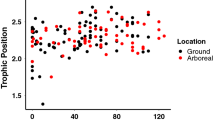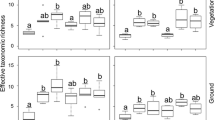Abstract
Predators have far-reaching effects on communities by triggering top-down trophic cascades that influence ecosystem functioning. Omnivory and intraguild interactions between predators give rise to reticulate food webs and may either strengthen or dampen trophic cascades depending on context. Disentangling the effects of multiple predator species is therefore crucial for predicting the influence of predators on community structure. We focused on ants as dominant generalist predators in arthropod communities and set up a differential ant exclusion from canopies to examine its effects on assemblage species composition and densities of five arthropod groups (psocopterans, aphids, spiders, heteropterans and beetles). We coupled a glue band with tubes allowing only the ant Lasius grandis to reach the canopies to isolate its effect from the rest of crawling predators (ants, earwigs) and compared it against a full exclusion and a control. L. grandis alone had widespread effects on assemblage species composition, with contrasting species-specific responses within groups, where some species affected by L. grandis presence were not further affected by the presence of the whole crawling predator assemblage, and vice versa. Overall, L. grandis caused two- to threefold decreases of generalist predators and a threefold increase of aphids. However, it lacked further top-down effects on primary consumers, which only emerged when all crawling predators were present. This differential exclusion demonstrates the distinctive and widespread intraguild effects on community structure of a single ant species that contrast with the top-down effects exerted by the whole crawling predator assemblage.



Similar content being viewed by others
References
Anderson MJ (2001) A new method for non-parametric multivariate analysis of variance. Austral Ecol 26:32–46
Arim M, Marquet PA (2004) Intraguild predation: a widespread interaction related to species biology. Ecol Lett 7:557–564. doi:10.1111/j.1461-0248.2004.00613.x
Beckers R, Deneubourg J-L, Goss S (1992) Trail laying behaviour during food recruitment in the ant Lasius niger (L.). Insectes Soc 39:59–72
Birkhofer K, Gavish-Regev E, Endlweber K, Lubin YD, von Berg K, Wise DH, Scheu S (2008) Cursorial spiders retard initial aphid population growth at low densities in winter wheat. Bull Entomol Res 98:249–255. doi:10.1017/S0007485308006019
Buckley RC (1987) Interactions involving plants, Homoptera, and ants. Annu Rev Ecol Syst 18:111–135
Chu HF (1949) How to know the immature insects. Brown, Dubuque
Davenport JM, Chalcraft DR (2012) Evaluating the effects of trophic complexity on a keystone predator by disassembling a partial intraguild predation food web. J Anim Ecol 81:242–250. doi:10.1111/j.1365-2656.2011.01906.x
Deffernez L, Champagne P, Verhaeghe J-C, Josens G, Loreau M (1990) Analysis of the spatio-temporal niche of foraging grassland ants in the field. Insectes Soc 37:1–13
Fauvel G (1999) Diversity of Heteroptera in agroecosystems: role of sustainability and bioindication. Agric Ecosyst Environ 74:275–303. doi:10.1016/S0167-8809(99)00039-0
Finke DL, Denno RF (2005) Predator diversity and the functioning of ecosystems: the role of intraguild predation in dampening trophic cascades. Ecol Lett 8:1299–1306. doi:10.1111/j.1461-0248.2005.00832.x
García LV (2004) Escaping the Bonferroni iron claw in ecological studies. Oikos 105:657–663
Gotelli NJ (2004) A taxonomic wish-list for community ecology. Philos Trans R Soc Lond B Biol Sci 359:585–597. doi:10.1098/rstb.2003.1443
Hagen KS (1962) Biology and ecology of predaceous Coccinellidae. Annu Rev Entomol 7:289–326
Hairston NG, Smith FE, Slobodkin LB (1960) Community structure, population control, and competition. Am Nat 94:421–425
Heino J (2014) Taxonomic surrogacy, numerical resolution and responses of stream macroinvertebrate communities to ecological gradients: are the inferences transferable among regions? Ecol Ind 36:186–194. doi:10.1016/j.ecolind.2013.07.022
Hölldobler B, Wilson EO (1990) The ants. Harvard University Press, Cambridge
Ives AR, Cardinale BJ, Snyder WE (2005) A synthesis of subdisciplines: predator-prey interactions, and biodiversity and ecosystem functioning. Ecol Lett 8:102–116. doi:10.1111/j.1461-0248.2004.00698.x
Karp DS, Daily GC (2014) Cascading effects of insectivorous birds and bats in tropical coffee plantations. Ecology 95:1065–1074. doi:10.1890/13-1012.1
Lima SL, Dill LM (1990) Behavioral decisions made under the risk of predation: a review and prospectus. Can J Zool 68:619–640
Maas B, Clough Y, Tscharntke T (2013) Bats and birds increase crop yield in tropical agroforestry landscapes. Ecol Lett 16:1480–1487. doi:10.1111/ele.12194
Majka CG, Langor D, Rücker WH (2009) Latridiidae (Coleoptera) of Atlantic Canada: new records, keys to identification, new synonyms, distribution, and zoogeography. Can Entomol 141:317–370. doi:10.4039/1109-050
Marc P, Canard A (1997) Maintaining spider biodiversity in agroecosystems as a tool in pest control. Agric Ecosyst Environ 62:229–235. doi:10.1016/S0167-8809(96)01133-4
Marín L, Jackson D, Perfecto I (2014) A positive association between ants and spiders and potential mechanisms driving the pattern. Oikos. doi:10.1111/oik.01913
Maurer D (2000) The dark side of taxonomic sufficiency (TS). Mar Pollut Bull 40:98–101. doi:10.1016/s0025-326x(99)00235-0
McIver JD, Stonedahl G (1993) Myrmecomorphy: morphological and behavioral mimicry of ants. Annu Rev Entomol 38:351–379
Mestre L, Piñol J, Barrientos JA, Cama A, Espadaler X (2012) Effects of ant competition and bird predation on the spider assemblage of a citrus grove. Basic Appl Ecol 13:355–362. doi:10.1016/j.baae.2012.04.002
Mestre L, Garcia N, Barrientos JA, Espadaler X, Piñol J (2013a) Bird predation affects diurnal and nocturnal web-building spiders in a Mediterranean citrus grove. Acta Oecol 47:74–80. doi:10.1016/j.actao.2013.01.001
Mestre L, Piñol J, Barrientos JA, Espadaler X (2013b) Ant exclusion in citrus over an 8-year period reveals a pervasive yet changing effect of ants on a Mediterranean spider assemblage. Oecologia 173:239–248. doi:10.1007/s00442-013-2594-y
Mestre L, Piñol J, Barrientos JA, Espadaler X, Brewitt K, Werner C, Platner C (2013c) Trophic structure of the spider community of a Mediterranean citrus grove: a stable isotope analysis. Basic Appl Ecol 14:413–422. doi:10.1016/j.baae.2013.05.001
Mestre L, Bucher R, Entling MH (2014) Trait-mediated effects between predators: ant chemical cues induce spider dispersal. J Zool 293:119–125. doi:10.1111/jzo.12127
Mooney KA (2006) The disruption of an ant-aphid mutualism increases the effects of birds on pine herbivores. Ecology 87:1805–1815. doi:10.1890/0012-9658(2006)87[1805:TDOAAM]2.0.CO;2
Mooney KA (2007) Tritrophic effects of birds and ants on a canopy food web, tree growth, and phytochemistry. Ecology 88:2005–2014. doi:10.1890/06-1095.1
Moreira X, Mooney KA, Zas R, Sampedro L (2012) Bottom-up effects of host-plant species diversity and top-down effects of ants interactively increase plant performance. Proc R Soc B Biol Sci 279:4464–4472. doi:10.1098/rspb.2012.0893
Moya-Laraño J, Wise DH (2007) Direct and indirect effects of ants on a forest-floor food web. Ecology 88:1454–1465. doi:10.1890/05-1474
Oksanen J, Blanchet FG, Kindt R, Legendre P, Minchin PR, O’Hara RB, Simpson GL, Solymos P, Stevens MHH, Wagner H (2013) Vegan: community ecology package. R package version 2.0.0-10. http://CRAN.R-project.org/package=vegan
Pekas A, Tena A, Aguilar A, Garcia-Marí F (2011) Spatio-temporal patterns and interactions with honeydew-producing Hemiptera of ants in a Mediterranean citrus orchard. Agric For Entomol 13:89–97. doi:10.1111/j.1461-9563.2010.00501.x
Piñol J, Espadaler X, Cañellas N, Pérez N (2009) Effects of the concurrent exclusion of ants and earwigs on aphid abundance in an organic citrus grove. Biocontrol 54:515–527. doi:10.1007/s10526-008-9203-8
Piñol J, Espadaler X, Cañellas N, Martínez-Vilalta J, Barrientos JA, Sol D (2010) Ant versus bird exclusion effects on the arthropod assemblage of an organic citrus grove. Ecol Entomol 35:367–376. doi:10.1111/j.1365-2311.2010.01190.x
Piñol J, Espadaler X, Cañellas N (2012) Eight years of ant-exclusion from citrus canopies: effects on the arthropod assemblage and on fruit yield. Agric For Entomol 14:49–57. doi:10.1111/j.1461-9563.2011.00542.x
Polis GA, Myers CA, Holt RD (1989) The ecology and evolution of intraguild predation: potential competitors that eat each other. Annu Rev Ecol Syst 20:297–330
R Development Core Team (2013) R: a language and environment for statistical computing. R Foundation for Statistical Computing, Vienna. http://www.R-project.org/
Romeu-Dalmau C, Espadaler X, Piñol J (2010) A simple method to differentially exclude ants from tree canopies based on ant body size. Methods Ecol Evol 1:188–191. doi:10.1111/j.2041-210X.2010.00015.x
Romeu-Dalmau C, Pinol J, Agustí N (2012) Detecting aphid predation by earwigs in organic citrus orchards using molecular markers. Bull Entomol Res 102:566–572. doi:10.1017/S0007485312000132
Rosumek FB, Silveira FA, Neves FdS, Barbosa NPdU, Diniz L, Oki Y, Pezzini F, Fernandes GW, Cornelissen T (2009) Ants on plants: a meta-analysis of the role of ants as plant biotic defenses. Oecologia 160:537–549. doi:10.1007/s00442-009-1309-x
Sanders D, Platner C (2007) Intraguild interactions between spiders and ants and top-down control in a grassland food web. Oecologia 150:611–624. doi:10.1007/s00442-006-0538-5
Sanders D, van Veen FJ (2011) Ecosystem engineering and predation: the multi-trophic impact of two ant species. J Anim Ecol 80:569–576. doi:10.1111/j.1365-2656.2010.01796.x
Sanders D, Schaefer M, Platner C, Griffiths GJK (2011) Intraguild interactions among generalist predator functional groups drive impact on herbivore and decomposer prey. Oikos 120:418–426. doi:10.1111/j.1600-0706.2010.18924.x
Schmitz OJ (2007) Predator diversity and trophic interactions. Ecology 88:2415–2426. doi:10.1890/06-0937.1
Schmitz OJ, Suttle KB (2001) Effects of top predator species on direct and indirect interactions in a food web. Ecology 82:2072–2081. doi:10.1890/0012-9658(2001)082[2072:EOTPSO]2.0.CO;2
Schmitz OJ, Hawlena D, Trussell GC (2010) Predator control of ecosystem nutrient dynamics. Ecol Lett 13:1199–1209. doi:10.1111/j.1461-0248.2010.01511.x
Schneider FD, Brose U (2013) Beyond diversity: how nested predator effects control ecosystem functions. J Anim Ecol 82:64–71. doi:10.1111/1365-2656.12010
Sih A, Englund G, Wooster D (1998) Emergent impacts of multiple predators on prey. Trends Ecol Evol 13:350–355. doi:10.1016/S0169-5347(98)01437-2
Sitvarin MI, Rypstra AL (2014) The importance of intraguild predation in predicting emergent multiple predator effects. Ecology 95:2936–2945. doi:10.1890/13-2347.1
Timms LL, Bowden JJ, Summerville KS, Buddle CM, Didham R, Basset Y (2013) Does species-level resolution matter? Taxonomic sufficiency in terrestrial arthropod biodiversity studies. Insect Conserv Divers 6:453–462. doi:10.1111/icad.12004
Vance-Chalcraft HD, Rosenheim JA, Vonesh JR, Osenberg CW, Sih A (2007) The influence of intraguild predation on prey suppression and prey release: a meta-analysis. Ecology 88:2689–2696. doi:10.1890/06-1869.1
Werner EE, Peacor SD (2003) A review of trait-mediated indirect interactions in ecological communities. Ecology 84:1083–1100. doi:10.1890/0012-9658(2003)084[1083:AROTII]2.0.CO;2
Acknowledgments
We are grateful to Núria Cañellas for assistance with the fieldwork and to the following colleagues for species identifications: Helena Pascual (Psocoptera), Nicolás Pérez (Aphididae), Jordi and Eva Ribes (Heteroptera), Josep Muñoz (Coleoptera).
Author contribution statement
J. P., J. A. B., and X. E. designed and performed the experiment. L. M. processed the data, performed statistical analyses and wrote the manuscript; other authors provided editorial advice.
Author information
Authors and Affiliations
Corresponding author
Ethics declarations
Conflict of interest
The authors declare that they have no conflict of interest.
Funding
Two grants from the Ministerio de Ciencia e Innovación-Fondo Europeo de Desarrollo Regional (MICINN-FEDER; CGL2007-64080-C02-01/BOS, CGL2010-18182) funded this study.
Additional information
Communicated by Raphael Didham.
Electronic supplementary material
Below is the link to the electronic supplementary material.
Rights and permissions
About this article
Cite this article
Mestre, L., Piñol, J., Barrientos, J.A. et al. Differential ant exclusion from canopies shows contrasting top-down effects on community structure. Oecologia 180, 193–203 (2016). https://doi.org/10.1007/s00442-015-3442-z
Received:
Accepted:
Published:
Issue Date:
DOI: https://doi.org/10.1007/s00442-015-3442-z




